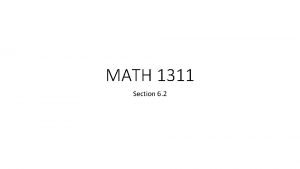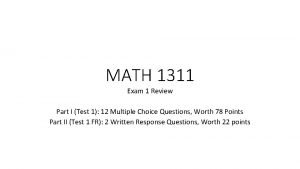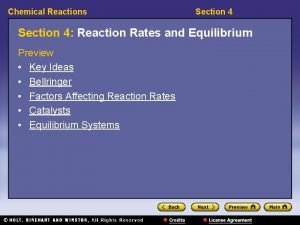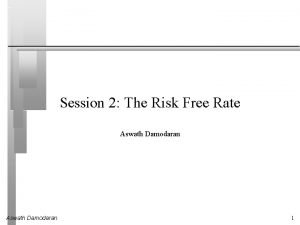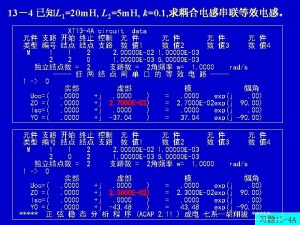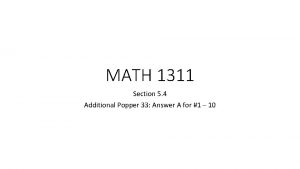MATH 1311 Section 6 2 Examples of Rates











- Slides: 11

MATH 1311 Section 6. 2

Examples of Rates of Change If the function S(t) is the directed distance of an object, its rate of change is denoted: d. S/dt and is the velocity of the object. If the function V(t) is the velocity of an object, its rate of change is denoted: d. V/dt and is the acceleration of the object. If the function T(D) is the amount of tax that is paid, its rate of change is denoted: d. T/d. D and is the marginal tax rate. If the function P(i) is the profit from an investment, its rate of change is denoted: d. P/di and is the marginal profit.

Common Properties of Rates of Change

Example: You are driving at a constant velocity. You encounter a slow-moving truck and accelerate to pass the truck. Once you pass the truck, you return to your previous speed. Let V(t) represent your velocity. Describe d. V/dt in terms of this situation. Graph V(t) indicating when the pass began, ended, and when the truck was overtaken. Graph d. V/dt and indicate the same points on the graph.

Example: You are driving at a constant velocity. You encounter a slow-moving truck and accelerate to pass the truck. Once you pass the truck, you return to your previous speed. Let V(t) represent your velocity.

When the Rate of Change is Zero • If the rate of change is steady at zero, this means that the function being measured is not changing. • If the rate of change passes briefly through zero, such as when switching from positive to negative, that is when the function being measured changes direction.

When Rate of Change is Constant When the rate of change is constant, the function being measured is linear. The slope of the that function is the rate of change: f(x) = mx + b is the same as f(x) = (df/dx)x + b

Example: A tire is filled to recommended p. s. i, p(t), but has a slow leak. The tire is losing pressure constantly. After several hours, an air pump has been attached and pressure begins to increase again until it reaches its previous air pressure. Explain the meaning of dp/dt in terms of this situation. If pressure is decreasing at 1 psi per hour, what is the value of dp/dt? Once a pump is attached, the pressure is increasing at 10 psi per hour. What is the value of dp/dt? Sketch a graph of both p(t) and dp/dt in terms of time. Label on each where the air pump is attached.


Popper 30 The height of a stone thrown is given by the function: h(t) = -16 t 2 + 64 t + 6 where t is measured in seconds and h is measured in feet. Graph the height function of the stone. 3. Based on this graph, where will dh/dt = 0? a. 1 b. 2 c. 6 d. 64 4. Where will dh/dt < 0? a. (0, 2) b. (2, 4) c. (0, 1) d. (1, 4) 5. Where will dh/dt > 0? a. (0, 2) b. (2, 4) c. (0, 1) d. (1, 4)

Popper 30…continued. 6. Describe, based on the terms in this situation, the meaning of dh/dt: a. b. c. d. It is the height of the stone while in the air. It is the change in height of the stone over the entire flight. It is the change in the height of the stone as time increases by 1 sec. It describes the path of the stone’s trajectory.
